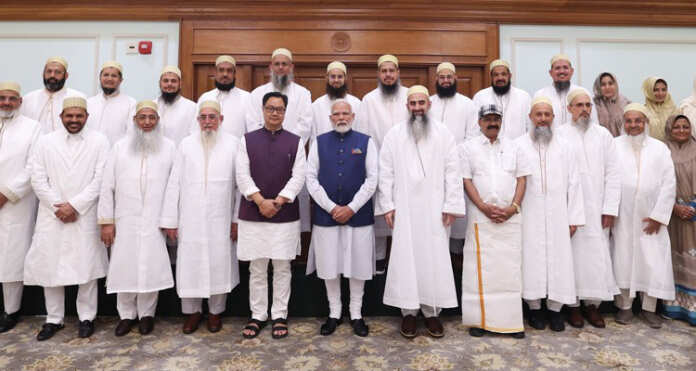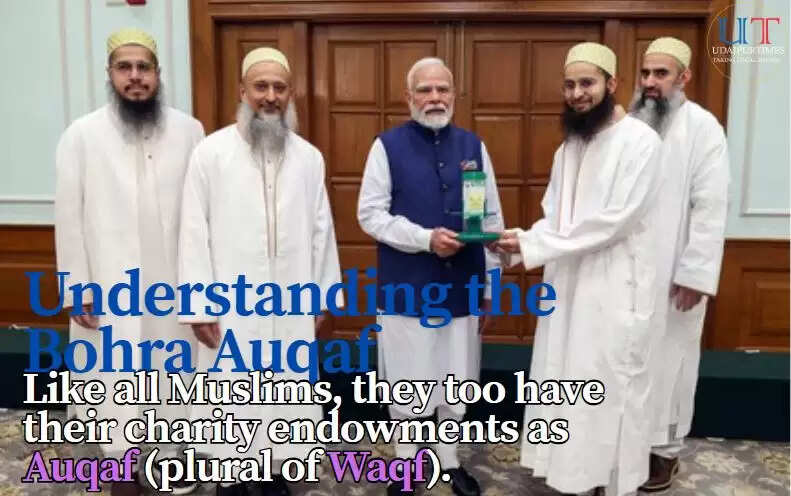Bohra Auqaf: A Historical Journey of Autonomy, Authority and Contention
Udaipur, April 27, 2025 - Ever since our Prime Minister declared his relationship with the Dawoodi Bohra community, himself as a member of its parivaar, the Bohras, especially a faction of Dawoodi Bohras headed by Sayyedna Mufaddal Saifuddin saheb, are in the news and all sort of stories about their social and religious beliefs are in circulation in media - print as well as electronic.
The Dawoodi Bohras
Bohras are Shia'a Muslims and a sub-sect of Shia'a Ismaili branch of Islam having its unique world view and doctrines, tenets and belief system under a tight centrally controlled social structure and priesthood akin to its closely linked other Shia'a Ismaili Branch headed by the Aga Khan.
In numbers, Bohras hold a miniscule status in the community of world Muslim Ummah - less than two million in over one and a half billion Muslim population around the globe. Yet, they have a unique status of their own because of their social structure and identity. Like all Muslims, they too have their charity endowments as Auqaf (plural of Waqf).

The Auqaf of the Muslims have been managed in different customary ways by their local jamaats and there was never a central control or superintendence - either regionally or provincially or nationally. Such an arrangement must have resulted in the possibilitties of misappropriation, encroachments and misuse of big chunks of land, buildings, graveyards, musafirkhanas and other such properties.
Waqf Acts in British India
In India, it was in the year 1923 that for the first time an Act was enacted for the then British Bombay and other Presidencies and called Mussalman Waqf Act, 1923 to supervise and regulate the Waqf properties of the Muslim community residing in those provinces. The details in subsequent paragraphs are related to only the Bombay Presidency.
The Bohras had their central headquarters in Bombay that time and the Bohra Auqaaf were under the control of the Bohra establishment headed by their head priest, viz. the Dai-ul-Mutlaq or Sayyedna. The Act was made effective after passing through various stages in year 1925.
Exemption from Waqf Acts
It was the time when the Bohra priesthood had just paseed through a difficult period of litigation known as Chaanda Bhai Galla case. It was a case filed by a few reformist Bohra leaders scattered across different provinces of undivided India, seeking accountability from their priestly establishment. There were also a few more cases in different Courts of law but for the purpose of community Waqf properties, the Chaanda Bhai case is more relevant.
The then Bombay High Court, though dismissing and rejecting many tall claims of religious and corporal authorities, however gave two important rulings, which proved a bonanza for the then and subsequent High Priests. In one of this it declared that the Sayyedna was accountable as per the rule of the land as sole trustee of community properties and rejected the claim of the Sayyedna of his accoutability to the Imam in seclusion only and to no one else. In the second ruling, the Court gave him power to excommunicate a Bohra from the community on religious ground.
It was under this circumstance that the Mussalaman Wakf Act, 1923 was promulgated and made effective from year 1925 as mentioned above. In this Act a clause permitted the provincial governments to exempt any sect or subsect of Muslims from its purview. The then Sayyedna, taking advantage of this clause, sought and got exemption for three years from 1926 to 1929. Moreover, such exemptions if given were to be reviewed after three years and if found necessary may further be extended for another three years.
During the currency of this exemption period, the powers of sole trusteeship and the excommunication given by the honourable Bombay High Court were gainfully used by the priestly establishment to further its grip on the community and getting all the trusts and their properties transferred under its control, through carefully drafted documents prepared by renowned lawyers and solicitors of the time. It is alleged that a large number of trusts and their properties were thus brought under the sole trusteeship of the Sayyedna saheb and the process continued.
Alarmed by this development, the Bohra dissidents who fought to seek accountability of the priestly establishment and other concerned individuals and groups came forward to intervene and get the exemption withdrawn at the earliest. For this purpose, in year 1928 Dawoodi Bohra Waqf and Trust Welfare Association was formed under the secretaryship of one TM Mandviwala. Through a heroic battle and a focussed approach, this group was able to achieve their objective in July 1935 and the Bohra Auqaf was brought back under the purview of Wakf Act 1923. The other provinces also followed the same action wherever the association had sent their requests for termination of exemption. The full story of the struggle and the counter moves taken by the then Sayyedna saheb is given in the report prepared by the late Mandvivala for the members and supporters of the Dawoodi Bohra Waqf and Trust Welfare Association.
As per this report, apart from a few prominent Bohra dignitories and concerned individuals from all over undivided India the report appreciated the aid extended by Young Men Bohra Association, Mumbai and Karachi respectively, Hakimiya Society Burhanpur and Dawoodi Bohra Haidery Club, Malegaon.
Sole Trusteeships of Waqf Properties in Independent India
In the year 1954, for the first time an all India Waqf Act was passed by the Indian Parliament for the superintendence of Muslim Auqaf throughout India and each State was mandated to establish their respective Waqf Boards for the superintendence of the Muslim Auqaf in their States under the supervision or management of a Mutawalli for each Waqf. This Act has the provision for the establishment of separate Sunni and Shia'a Boards if the Shia'a Auqaf constitute more than a percentage mentioned in the Act. The Act also has given power to the State Goverments to adopt systems other than Mutawalli system of management if the same is considered necessary and more effective.
Bohras belong to the Shia'a faction as mentioned above. In many states the Bohra Auqaf, together with other Shia'a groups, exceed the limit mentioned in the Act and the Bohra Auqaf constitute the largest portion. Taking advantage of these provisions, the then Sayyedna saheb is said to have demanded a separate Shia'a Board or a system of management in which he is the sole trustee of all the Bohra Auqaf.
To begin with, the Gazzette notification of the registered Waqf properties in Rajasthan was promugated in the year 1966. In the year 1970, the Rajasthan government signed an MOU with Sayyedna saheb by which the latter was made sole trustee of the Bohra Auqaf by paying a fixed annual amount to the Rajasthan Board for a period of three years. This term was to be reviewed for the annual fixed payments and then its extension for another three years. This arrangement gave full administrative and operational control of Bohra Auqaaf to Sayyedna saheb by paying a paltry sum to the State Waqf Boards.
Prima facie, such an arrangement appears strange and almost laughable because by this analogy, a tehsildar can actually hand over the administrative and revenue collection of villages under his jurisdiction to a landlord on payment of a lumpsum and relax! Can a Collector do the same for his district? But such was the situation in the case of Bohra Auqaf in Rajasthan. Moreover, this system came into action in Madhya Pradesh and other states also where Bohra Auqaf were involved.
In 1973 there was an uprising in the Bohra community in Udaipur in the wake of violent incidents in Galiakot town of Dungarpur district. The victims were the supporters and sympathisers of Bohra Youth Association which had spearheaded a movement for reforms in the year 1970. The reformists were ex-communicated and denied entries in their Auqaf of which they were also beneficiaries. When they came to know about the MoU by which Sayyedna saheb was made the sole trustee, they opposed this and took up the matter with the government like the one taken up by the reformists of the erstwhile Bombay Presidency. Although once when a question on behalf of the reformist was raised in the State Legislature by the then Udaipur MLA, the then Minister in charge of Minority Affairs admitted in the State Legislature that the agreement was illegal and will be struck off. However, nothing happened on the ground. Tired and exhausted, the reformists filed a suit in the Waqf Tribunal at Jaipur in year 2005. The file is lying in the tribunal... still awaiting movement.
The 1954 Act was repealed in the year 1995 and amended in year 2013. But the sole trusteeship survived and continued.
Exemption under Waqf (Amendment) Act, 2025
As of now, the Bohra Auqaf in India is totally free from the purview of the amended Waqf Act of year 1995 and the Bohra religious establishment has no connection with any State Waqf Board and will manage and control Bohra Auqaf through their own trust.
So liberated, if the Bohra delegation from Sayyedna Mufaddal saheb extend support and greet our honourable PM, it is not doing a favour to him.
However, the jubilliant Bohras should note that the English concept of TRUST is different from the Islamic concept of WAQF. In the Waqf the property is devoted to Allah, The Almighty. The property in a Trust, on the other hand, is in the custody of a trustee who has full control over it. The motive in Waqf is pious and religious while the motive in Trust is corporeal. A Waqf cannot be sold or transferred whereas a property in Trust can be. Their ‘Zar’ - or wealth - and ‘Zameen’ - land and properties - are now in the custody of a trustee.
In the end, here is an appeal to the angry non-Bohra Muslims:
Do not target Bohras by using hostile terminology as their system, religious beliefs and social structure has been different since centuries. Also. as mentioned above, even during the currency of Waqf Acts since year 1923 till the present controversy, their Auqaf have been delinked from the province and State Waqf Boards and fully autonomous in operation. Furthermore, the present amended act in its early stage had envisaged a separate Waqf Board for Dawoodi Bohras and it is now that they have been freed from the purview of the amended Waqf Act 1995. As regards support to the ruling party, there are thousands of Muslims who rally for it, are members of its affiliated organisations and even ministers, spokespersons and senior leaders since years.
Sayyedna Mufaddal Saifuddin saheb is the religious head of only a faction of Dawoodi Bohras which is in a majority. The Alavi Bohras, Atba e Malak Bohras who have their own Sayyedna and Malaks are also basically Dawoodi. The Bohras of Malegaon who consider the 47th Dai onwards as only a managing Dai as against a Mutlaq Dai are also Dawoodi. The reformists of Udaipur and other parts of India as also those in the Middle East countries, East African countries, the UK, Canada and USA, are all Dawoodi Bohras and consider the current Dai as their religious head but differ in matters of secular subjects .
Furthermore, even the position and status of Sayyedna Mufaddal saheb has been contested first by his uncle Khuzema Qutbuddin saheb and, after his death, his son Taher Fakhruddin.
To join us on Facebook Click Here and Subscribe to UdaipurTimes Broadcast channels on GoogleNews | Telegram | Signal



